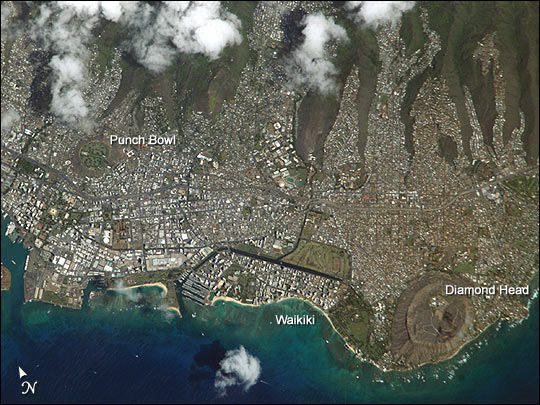


The Expedition 7 crew on the International Space Station is set to come home to Earth in about a week. Crew member Ed Lu considers Honolulu to be his hometown, and the view from a recent overpass inspired him to photograph the city.
Honolulu is striking for the way it is bound by surrounding geography. Built-up fingers of the city extend northeast onto the steep volcanic slopes and surround the volcanic craters of Punchbowl and Diamond Head, leaving undeveloped only parklands and the steepest ridges. They are both tuff cones that formed as magma from the erupting volcano came in contact with ground water at a time when sea levels were higher than they are now. As the water turned to steam, it caused an explosion that formed a hill of ash with a broad crater in the center.
In Hawaiian, Punchbowl Crater was known as Pu’owaina, or “Hill of Sacrifice,” and was a site of royal burials. Punchbowl is also the site of the National Memorial Cemetery of the Pacific. The area includes more than 38,000 graves of U.S. service men and women beginning with casualties of the attack on Pearl Harbor in 1941. Ellison Onizuka, one of the Space Shuttle Challenger crew killed in 1986, is also buried there.
Diamond Head was called Le’ahi in Hawaiian, or “Brow of the yellowfin tuna (ahi),” British sailors in the 1700s saw calcite crystals sparkling on the crater and gave it its English name. One of the major “must see” tourist destinations on Oahu, Diamond Head is managed as a Hawaii State Monument, and plans are in place to reduce vehicle traffic and restore the natural vegetation.
Astronaut photograph ISS007-E-16813 was taken from the International Space Station on October 8, 2003, with a Kodak DCS760 digital camera equipped with an 800 mm lenses. Image content was provided by Cynthia A. Evans (Lockheed Martin/Earth Observations Laboratory, Johnson Space Center). The International Space Station Program supports the laboratory to help astronauts take pictures of Earth that will be of the greatest value to scientists and the public, and to make those images freely available on the Internet. Additional images taken by astronauts and cosmonauts can be viewed at the NASA/JSC Gateway to Astronaut Photography of Earth.